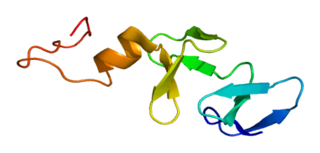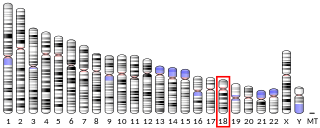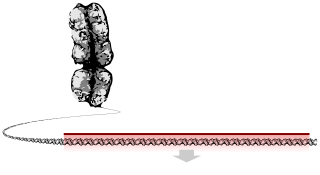
Mucin 5AC (Muc5AC) is a protein that in humans is encoded by the MUC5AC gene.

AT-rich interactive domain-containing protein 3B is a protein that in humans is encoded by the ARID3B gene.

Cysteine and glycine-rich protein 2 is a protein that in humans is encoded by the CSRP2 gene.

Cysteine-rich secretory protein 1 is a cysteine-rich secretory protein that in humans is encoded by the CRISP1 gene.

Cysteine-rich secretory protein 2 is a cysteine-rich secretory protein that in humans is encoded by the CRISP2 gene.

Cysteine-rich secretory protein LCCL domain-containing 2 is a cysteine-rich secretory protein that in humans is encoded by the CRISPLD2 gene.

Cysteine-rich protein 1 is a protein that in humans is encoded by the CRIP1 gene.

Zinc finger and BTB domain containing 11 is a protein that in humans is encoded by the ZBTB11 gene.

Calpain 6 is a protein in humans that is encoded by the CAPN6 gene.

Inositol monophosphatase 3 also known as inositol monophosphatase domain-containing protein 1 (IMPAD1) is an enzyme that in humans is encoded by the IMPAD1 gene.

Family with sequence similarity 69, member C is a protein that in humans is encoded by the FAM69C gene.

Zinc finger protein 180 is a protein that is encoded in humans by the ZNF180 gene.

MyoD family inhibitor domain containing is a protein that in humans is encoded by the MDFIC gene.

Leucine-rich repeats and death domain containing 1 is a protein that in humans is encoded by the LRRD1 gene.

Microseminoprotein, prostate associated is a protein that in humans is encoded by the MSMP gene.

Scavenger receptor cysteine rich family member with 4 domains is a protein that in humans is encoded by the SSC4D gene.

LIM homeobox 9 is a protein that in humans is encoded by the LHX9 gene.

TM2 domain containing 1 is a protein that in humans is encoded by the TM2D1 gene.

Cysteine rich protein 3 is a protein that in humans is encoded by the CRIP3 gene.

ADP-ribosyltransferase 5 is a protein that in humans is encoded by the ART5 gene.



















